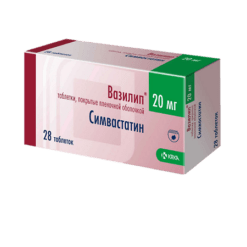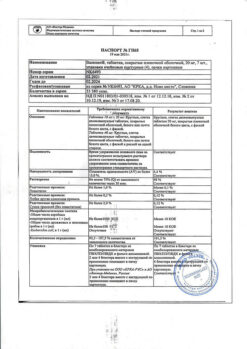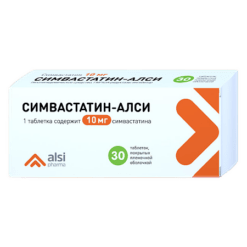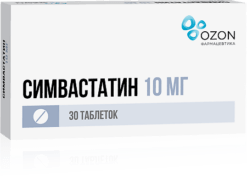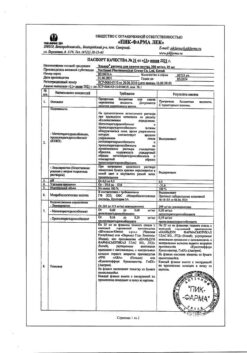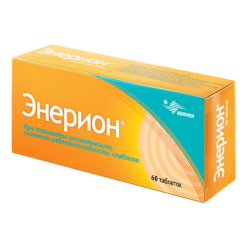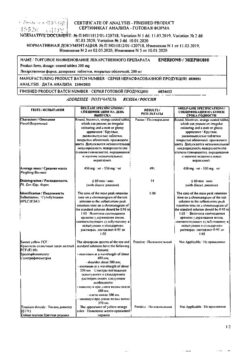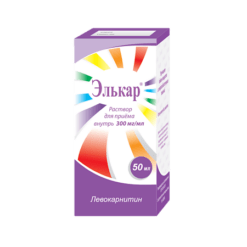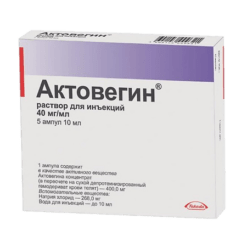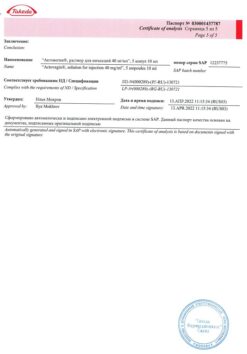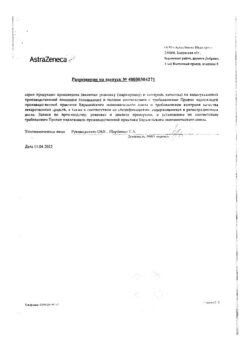No products in the cart.
Simvastatin, 40 mg 30 pcs
€1.00
Out of stock
(E-mail when Stock is available)
Description
Simvastatin is a hypolipidemic drug synthetically derived from the fermentation product of Aspergillus terreus, is an inactive lactone, it undergoes hydrolysis in the body to form a hydroxy acid derivative. The active metabolite inhibits 3-hydroxy-3-methylglutaryl-CoA reductase (HMG-CoA reductase), the enzyme that catalyzes the initial reaction of mevalonate formation from HMG-CoA. Since the conversion of HMG-CoA to mevalonate represents an early step in cholesterol synthesis, the use of simvastatin does not cause accumulation of potentially toxic sterols in the body. HMG-CoA is easily metabolized to acetyl-CoA, which is involved in many synthesis processes in the body.
It lowers plasma levels of triglycerides (TG), low-density lipoproteins (LDL), very low-density lipoproteins (VLDL) and total cholesterol (in cases of heterozygous familial and non-familial hypercholesterolemia, in mixed hyperlipidemia, when elevated cholesterol is a risk factor).
Enhances high-density lipoprotein (HDL) and decreases the ratio of LDL/HDL and total cholesterol/HDL.
The onset of the effect is 2 weeks after the start of administration, the maximum therapeutic effect is achieved after 4-6 weeks. The effect is maintained during continuation of treatment, when discontinuing therapy cholesterol content gradually returns to baseline levels.
Pharmacokinetics
The absorption of simvastatin is high. After oral administration Cmax in plasma is reached after about 1.3 – 2.4 h and decreases by 90% after 12 h. The binding to plasma proteins is about 95%.
Metabolized in the liver, it has the effect of first passage through the liver (it is hydrolyzed with the formation of the active derivative: beta-hydroxy acid; other active and inactive metabolites have been found as well).
The T1/2 of active metabolites is 1.9 h. It is excreted mainly with the feces (60%) as metabolites. About 10-15% is excreted by the kidneys in the inactive form.
Indications
Indications
Patients with coronary heart disease or at high risk of coronary artery disease
In patients at high risk of developing CAD (with or without hyperlipidemia), such as patients with diabetes mellitus, patients with a history of stroke or other cerebrovascular disease, patients with peripheral vascular disease, or patients with CAD or a predisposition to CAD, Simvastatin is indicated for:
Reducing the risk of overall mortality by reducing mortality due to ischemic heart disease.
Reducing the risk of serious vascular and coronary complications:
non-fatal myocardial infarction,
coronary death
stroke,
revascularization procedures.
Reducing the risk of the need for surgical interventions to restore coronary blood flow (such as coronary artery bypass grafting and percutaneous transluminal coronary angioplasty).
Reducing the risk of the need for surgical interventions to restore peripheral blood flow and other types of non-coronary revascularization.
Reducing the risk of hospitalization due to angina attacks.
Hyperlipidemia
as an adjunct to diet when diet alone and other non-drug treatments in patients with primary hypercholesterolemia, including heterozygous familial hypercholesterolemia (Fredrickson type IIa hyperlipidemia), or mixed hypercholesterolemia (Fredrickson type IIb hyperlipidemia) are insufficient to:
reducing the increased concentration of total cholesterol, LDL cholesterol. TG, anolipoprotein B (apoB);
increasing the concentration of HDL cholesterol;
reducing the ratio of LDL cholesterol/HDL cholesterol and TC/HDL cholesterol.
hypertriglyceridemia (hyperlipidemia type IV according to the Fredrickson classification).
addition to diet and other treatments in patients with homozygous familial hypercholesterolemia to reduce elevated concentrations of total cholesterol, LDL cholesterol and apo B.
primary dysbetalipoproteinemia (hyperlipidemia type III according to the Fredrickson classification).
Use in children with heterozygous familial hypercholesterolemia
The use of simvastatin along with a diet is indicated to reduce elevated concentrations of total cholesterol, LDL cholesterol, TG, apo B in boys 10-17 years old and in girls 10-17 years old at least 1 year after menarche (first menstrual bleeding) with heterozygous familial hypercholesterolemia.
Pharmacological effect
Pharmacological effect
Simvastatin is a lipid-lowering drug obtained synthetically from the fermentation product of Aspergillus terreus, is an inactive lactone, and undergoes hydrolysis in the body to form a hydroxy acid derivative. The active metabolite inhibits 3-hydroxy-3-methyl-glutaryl-CoA reductase (HMG-CoA reductase), an enzyme that catalases the initial reaction of mevalonate formation from HMG-CoA. Since the conversion of HMG-CoA to mevalonate is an early step in cholesterol synthesis, the use of simvastatin does not cause the accumulation of potentially toxic sterols in the body. HMG-CoA is easily metabolized to acetyl-CoA, which is involved in many synthesis processes in the body.
Causes a decrease in the blood plasma levels of triglycerides (TG), low-density lipoproteins (LDL), very low-density lipoproteins (VLDL) and total cholesterol (in cases of heterozygous familial and non-familial forms of hypercholesterolemia, with mixed hyperlipidemia, when high cholesterol is a risk factor).
Increases the content of high-density lipoproteins (HDL) and reduces the LDL/HDL ratio and total cholesterol/HDL.
The onset of the effect is 2 weeks from the start of administration, the maximum therapeutic effect is achieved after 4-6 weeks. The effect persists with continued treatment; upon cessation of therapy, cholesterol levels gradually return to the original level.
Pharmacokinetics
Absorption of simvastatin is high. After oral administration, Cmax in blood plasma is reached after approximately 1.3 – 2.4 hours and decreases by 90% after 12 hours. The binding to plasma proteins is about 95%.
Metabolized in the liver, has a first-pass effect through the liver (hydrolyzes to form an active derivative: beta – hydroxy acids, other active and inactive metabolites have been found).
T1/2 of active metabolites is 1.9 hours. It is excreted mainly in feces (60%) in the form of metabolites. About 10-15% is excreted by the kidneys in an inactive form.
Special instructions
Special instructions
Myopathy/Rhabdomyolysis
Active ingredient
Active ingredient
Simvastatin
Composition
Composition
The tablet contains the active ingredient Simvastatin 40 mg.
Contraindications
Contraindications
Hypersensitivity to any component of the drug.
Liver disease in the active phase or persistent increase in the activity of “liver” transaminases in the blood plasma of unknown etiology.
Pregnancy or breastfeeding period.
Age up to 18 years (except for children 10-17 years old with heterozygous familial hypercholesterolemia) (see INDICATIONS FOR USE).
Lactose intolerance, lactase deficiency or glucose-galactose malabsorption.
Concomitant treatment with strong CYP3A4 inhibitors (itraconazole, ketoconazole, posaconazole, voriconazole, HIV protease inhibitors, boceprevir, telaprevir, erythromycin, clarithromycin, telithromycin, nefazodone and drugs containing cobicistat) (see INTERACTIONS WITH OTHERS) MEDICINES; SPECIAL INSTRUCTIONS, Myopathy/Rhabdomyolysis).
Concomitant treatment with gemfibrozil, cyclosporine or danazol (see INTERACTIONS WITH OTHER MEDICINES; SPECIAL INSTRUCTIONS. Myopathy/Rhabdomyolysis).
WITH CAUTION
Patients who have experienced rhabdomyolysis during simvastatin therapy with a complicated history (impaired renal function, usually due to diabetes mellitus) require more careful monitoring, and simvastatin therapy should be temporarily discontinued in such patients several days before major surgery, as well as in the postoperative period; in patients with persistently elevated serum transaminase activity (exceeding 3 times the upper limit of normal), the drug should be discontinued; in severe renal failure (CC 10 mg per day and, if necessary, they should be prescribed with caution; in case of alcohol abuse before starting treatment.
Side Effects
Side Effects
Simvastatin is generally well tolerated, and most side effects are mild and transient. Less than 2% of patients participating in clinical trials discontinued treatment due to the development of adverse events characteristic of the drug Simvastatin.
Interaction
Interaction
Contraindicated combinations of drugs
Concomitant therapy with the following drugs is contraindicated.
Strong inhibitors of the CYP3A4 isoenzyme. Simvastatin is metabolized by the CYP3A4 isoenzyme, but does not inhibit the activity of this isoenzyme. This suggests that taking simvastatin does not affect the plasma concentrations of drugs metabolized by the CYP3A4 isoenzyme. Strong inhibitors of the CYP3A4 isoenzyme increase the risk of developing myopathy by reducing the rate of elimination of simvastatin. Concomitant use of strong CYP3A4 inhibitors (e.g., itraconazole, ketoconazole, posaconazole, voriconazole, erythromycin, clarithromycin, telithromycin, HIV protease inhibitors, bocenrevir, gelaprevnra, nefazodone, drugs containing cobicistat) and simvastatin is contraindicated (see. CONTRAINDICATIONS; SPECIAL INSTRUCTIONS, Myopathy/Rhabdomyolysis).
Gemfibrozil, cyclosporine or danazol. See CONTRAINDICATIONS; SPECIAL INSTRUCTIONS. Myopathy/Rhabdomyolysis.
Interaction with other drugs
Other fibrates. The risk of developing myopathy increases with simultaneous use of simvastatin with gemfibrozil (see CONTRAINDICATIONS) and other fibers (except fenofibrate). These lipid-lowering drugs can cause myopathy in monotherapy. When simvastatin was used concomitantly with fenofibrate, the risk of developing myopathy did not exceed the sum of the risks with monotherapy with each drug (see CONTRAINDICATIONS; SPECIAL INSTRUCTIONS, Myopathy/Rhabdomyolysis).
Amiodarone. The risk of developing myopathy/rhabdomyolysis increases when amiodarone is used concomitantly with simvastatin. In a clinical study, the incidence of myopathy in patients taking simvastatin 80 mg and amiodarone concomitantly was 6% (see DOSES AND ADMINISTRATION; SPECIAL INSTRUCTIONS, Myopathy/Rhabdomyolysis).
Blockers of “slow” calcium channels. The risk of developing myopathy/rhabdomyolysis increases with concomitant use of verapamil. diltiazem or amlodipine with simvastatin (see DOSES AND ADMINISTRATION; SPECIAL INSTRUCTIONS, Myopathy/Rhabdomyolysis).
Lomitapide. The risk of myopathy/rhabdomyolysis may be increased when lomitapide is used concomitantly with simvastatin (see DOSAGE AND ADMINISTRATION; SPECIAL INSTRUCTIONS, Myopathy/Rhabdomyolysis).
Moderate inhibitors of the CYP3A4 isoenzyme (for example, dronedarone). With simultaneous use of drugs with moderate inhibitory activity against the CYP3A4 isoenzyme and simvastatin, especially at higher doses, the risk of developing myopathy may increase (see SPECIAL INSTRUCTIONS: Myopathy/Rhabdomyolysis). With simultaneous use of Simvastatin and moderate inhibitors of CYP3A4 isoenzymes, a reduction in the dose of Simvastatin may be required.
Ranolazine (moderate CYP3A4 inhibitor). With simultaneous use of ranolazine and simvastatin, the risk of developing myopathy may increase (see SPECIAL INSTRUCTIONS, Myopathy/Rhabdomyolysis). When using Simvastatin and ranolazine simultaneously, a reduction in the dose of Simvastatin may be required.
Inhibitors of the transport protein OATP1B1. Simvastatin hydroxy acid is a substrate of the transport protein OATP1B1. Concomitant use of OATP1B1 transport protein inhibitors and simvastatin may lead to an increase in plasma concentrations of the hydroxy acid simvastatin and an increased risk of developing myopathy (see CONTRAINDICATIONS; SPECIAL INSTRUCTIONS. Myopathy/Rhabdomyolysis).
Fusidic acid. Concomitant use of fusidic acid and simvastatin may increase the risk of developing myopathy (see SPECIAL INSTRUCTIONS: Myopathy/Rhabdomyolysis).
Nicotinic acid (at least 1 g/day). With the simultaneous use of simvastatin and nicotinic acid in lipid-lowering doses (at least 1 g/day), cases of myopathy/rhabdomyolysis have been described (see SPECIAL INSTRUCTIONS. Myopathy/Rhabdomyolysis).
Colchicine. With the simultaneous use of colchicine and simvastatin in patients with
renal failure, cases of myopathy and rhabdomyolysis have been described. When combined with these drugs, such patients should be closely monitored.
Indirect anticoagulants (coumarin derivatives). Simvastatin at a dose of 20-40 mg per day potentiates the effect of coumarin anticoagulants: prothrombin time, defined as the international normalized ratio (MHO), increases from the initial level of 1.7 to 1.8 in healthy volunteers and from 2.6 to 3.4 in patients with hypercholesterolemia. In patients taking coumarin anticoagulants, prothrombin time should be determined before starting simvastatin therapy, and also often enough during the initial period of treatment to exclude significant changes in this indicator. As soon as a stable MHO is achieved. its further determination should be carried out at intervals recommended for monitoring patients receiving anticoagulant therapy. When changing the dose of simvastatin or after its discontinuation, regular measurement of prothrombin time is also recommended. In patients not taking anticoagulants, simvastatin therapy was not associated with bleeding or changes in prothrombin time.
Other types of interaction
Grapefruit juice contains one or more components that inhibit CYP3A4 and may increase plasma concentrations of drugs metabolized by CYP3A4. When drinking the juice in the usual amount (1 glass 250 ml per day), this effect is minimal (there is an increase in the activity of HMG-CoA reductase inhibitors by 13% when assessed by AUC value) and has no clinical significance. However, drinking grapefruit juice in large volumes significantly increases the activity of HMG-CoA reductase inhibitors in the blood plasma. Therefore, grapefruit juice should be avoided during simvastatin therapy (see SPECIAL INSTRUCTIONS: Myopathy/Rhabdomyolysis).
Overdose
Overdose
Several cases of overdose were reported, the maximum dose taken was 3.6 g. No overdose effects were identified in any patient. To treat an overdose, general measures are used, including supportive and symptomatic therapy.
Storage conditions
Storage conditions
In a dry place, protected from light, at a temperature not exceeding 25°C. Keep out of the reach of children.
Shelf life
Shelf life
3 years.
Manufacturer
Manufacturer
Ozon, Russia
Additional information
| Shelf life | 3 years. |
|---|---|
| Conditions of storage | Store in a dry place protected from light at a temperature not exceeding 25°C. Keep out of reach of children. |
| Manufacturer | Ozon, Russia |
| Medication form | pills |
| Brand | Ozon |
Other forms…
Related products
Buy Simvastatin, 40 mg 30 pcs with delivery to USA, UK, Europe and over 120 other countries.


